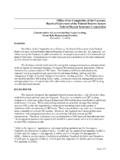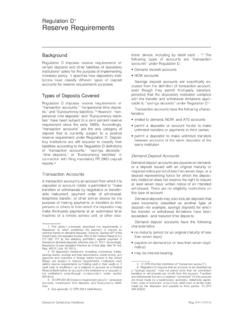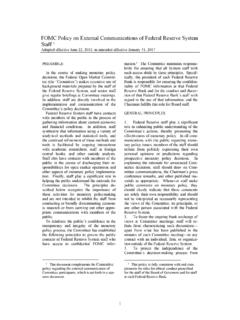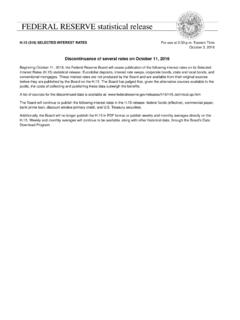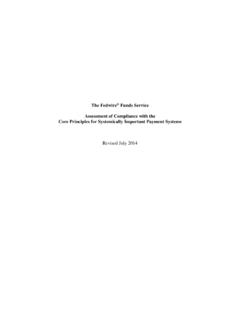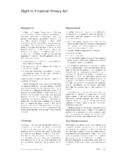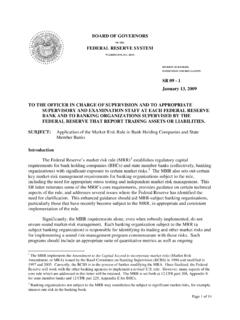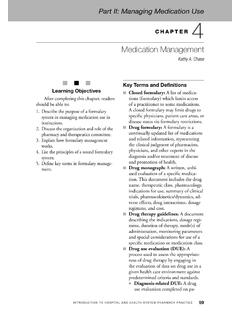Transcription of SR 11-7 attachment: Supervisory Guidance ... - Federal Reserve
1 Page 1 SR Letter 11-7 Attachment Board of Governors of the Federal Reserve System Office of the Comptroller of the Currency April 4, 2011 Supervisory Guidance ON MODEL RISK MANAGEMENT CONTENTS I. Introduction, page 1 II. Purpose and Scope, page 2 III. Overview of Model Risk Management, page 3 IV.
2 Model Development, Implementation, and Use, page 5 V. Model Validation, page 9 VI. Governance, Policies, and Controls, page 16 VII. Conclusion, page 21 I. INTRODUCTION Banks rely heavily on quantitative analysis and models in most aspects of financial decision making.
3 [Footnote 1 - Unless otherwise indicated, banks refers to national banks and all other institutions for which the Office of the Comptroller of the Currency is the primary supervisor, and to bank holding companies, state member banks, and all other institutions for which the Federal Reserve Board is the primary supervisor. End of Footnote 1.] They routinely use models for a broad range of activities, including underwriting credits; valuing exposures, instruments, and positions; measuring risk; managing and safeguarding client assets; determining capital and Reserve adequacy; and many other activities.
4 In recent years, banks have applied models to more complex products and with more ambitious scope, such as enterprise-wide risk measurement, while the markets in which they are used have also broadened and changed. Changes in regulation have spurred some of the recent developments, particularly the regulatory capital rules for market, credit, and operational risk based on the framework developed by the Basel Committee on Banking Supervision. Even apart from these regulatory considerations, however, banks have been increasing the use of data-driven, quantitative decision-making tools for a number of years.
5 The expanding use of models in all aspects of banking reflects the extent to which models can improve business decisions, but models also come with costs. There is the direct cost of devoting resources to develop and implement models properly. There are also the potential indirect costs of relying on models, such as the possible adverse consequences (including financial loss) of decisions based on models that are incorrect or misused. Those consequences should be addressed by active management of model risk. [Page Break] Page 2 This Guidance describes the key aspects of effective model risk management.
6 Section II explains the purpose and scope of the Guidance , and Section III gives an overview of model risk management. Section IV discusses robust model development, implementation, and use. Section V describes the components of an effective validation framework. Section VI explains the salient features of sound governance, policies, and controls over model development, implementation, use, and validation. Section VII concludes. II. PURPOSE AND SCOPE The purpose of this document is to provide comprehensive Guidance for banks on effective model risk management.
7 Rigorous model validation plays a critical role in model risk management; however, sound development, implementation, and use of models are also vital elements. Furthermore, model risk management encompasses governance and control mechanisms such as board and senior management oversight, policies and procedures, controls and compliance, and an appropriate incentive and organizational structure. Previous Guidance and other publications issued by the OCC and the Federal Reserve on the use of models pay particular attention to model validation.
8 [Footnote 2 - For instance, the OCC provided Guidance on model risk, focusing on model validation, in OCC 2000-16 (May 30, 2000), other bulletins, and certain subject matter booklets of the Comptroller's Handbook. The Federal Reserve issued SR Letter 09-01, "Application of the Market Risk Rule in Bank Holding Companies and State Member Banks," which highlights various concepts pertinent to model risk management, including standards for validation and review, model validation documentation, and back-testing. The Federal Reserve 's Trading and Capital-Markets Activities Manual also discusses validation and model risk management.]
9 In addition, the advanced-approaches risk-based capital rules (12 CFR 3, Appendix C; 12 CFR 208, Appendix F; and 12 CFR 225, Appendix G) contain explicit validation requirements for subject banking organizations. End of Footnote 2.] Based on Supervisory and industry experience over the past several years, this document expands on existing Guidance most importantly by broadening the scope to include all aspects of model risk management. Many banks may already have in place a large portion of these practices, but all banks should ensure that internal policies and procedures are consistent with the risk management principles and Supervisory expectations contained in this Guidance .
10 Details may vary from bank to bank, as practical application of this Guidance should be customized to be commensurate with a bank's risk exposures, its business activities, and the complexity and extent of its model use. For example, steps taken to apply this Guidance at a community bank using relatively few models of only moderate complexity might be significantly less involved than those at a larger bank where use of models is more extensive or complex. [Page Break] Page 3 III. OVERVIEW OF MODEL RISK MANAGEMENT For the purposes of this document, the term model refers to a quantitative method, system, or approach that applies statistical, economic, financial, or mathematical theories, techniques, and assumptions to process input data into quantitative estimates.
